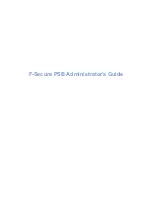
Volume 2, Part 2: Context Management
2:551
4.1.2
Preserving Floating-point Registers
The Itanium architecture encodes a floating-point register’s control speculative state as
a special unnormalized floating-point number called NaTVal. As a result, Itanium
floating-point registers do not have a NaT bit. The architecture provides the
stf.spill
and
ldf.fill
instructions to save and restore floating-point register values and control
speculative state. These instructions always generate a 16-byte memory image
regardless of the precision of the floating-point number contained in the register.
Preservation of data speculative state associated with floating-point registers needs to
be managed by software. As with the general registers, software is required to explicitly
invalidate a register’s ALAT entry using the
invala.e
instruction when restoring a
floating-point register. The Itanium calling conventions avoid such explicit ALAT
invalidations by disallowing data speculation to preserved floating-point registers
(FR2-5, FR16-31) across procedure calls.
4.2
Preserving Register State in the OS
The software calling conventions described in the previous section apply to state
preservation across procedure call boundaries. When entering the operating system
kernel either voluntarily (for a system call) or involuntarily (for handling an exception or
an external interrupt) additional concerns arise because the interrupted user’s context
needs to be preserved in its entirety.
The Itanium architecture defines a large register set: 128 general registers and 128
floating-point registers account for approximately 1 KByte and 2 KBytes of state,
respectively. The architecture provides a variety of mechanisms to reduce the amount
of state preservation that is needed on commonly executed code paths such as system
calls and high frequency exceptions such as TLB miss handlers.
Additionally, Itanium architecture-based operating systems have opportunities to
reduce the amount of context they need to save by distinguishing various kernel entry
and exit points. For instance, when entering the kernel on behalf of a voluntary system
call, the kernel need only preserve registers as outlined by the calling conventions.
Furthermore, the operating system can be sensitive to whether the preserved context is
coming from the IA-32 or Itanium instruction set, especially since the IA-32 register
context is substantially smaller than the full Itanium register set. Ideally, an Itanium
architecture-based operating system should use a single state storage structure which
contains a field that indicates the amount of populated state.
Table 4-2 summarizes several key operating system points at which state preservation
is needed.
Scratch GRs and FRs, the bulk of all state, only need to be preserved at involuntary
interruptions resulting from unexpected external interrupts or from exceptions that
need to call code written in a high-level programming language. The demarcation of
floating-point registers FR32-127 as “scratch” along with architectural support for lazy
state save/restore of the floating-point register file allows software to substantially
reduce the overhead of preserving the scratch FRs. See
for details.
Summary of Contents for ITANIUM ARCHITECTURE - SOFTWARE DEVELOPERS VOLUME 3 REV 2.3
Page 1: ......
Page 11: ...x Intel Itanium Architecture Software Developer s Manual Rev 2 3 ...
Page 13: ...1 2 Intel Itanium Architecture Software Developer s Manual Rev 2 3 ...
Page 33: ...1 22 Volume 1 Part 1 Introduction to the Intel Itanium Architecture ...
Page 57: ...1 46 Volume 1 Part 1 Execution Environment ...
Page 147: ...1 136 Intel Itanium Architecture Software Developer s Manual Rev 2 3 ...
Page 149: ...1 138 Volume 1 Part 2 About the Optimization Guide ...
Page 191: ...1 180 Volume 1 Part 2 Predication Control Flow and Instruction Stream ...
Page 230: ......
Page 248: ...236 Intel Itanium Architecture Software Developer s Manual Rev 2 3 ...
Page 250: ...2 2 Intel Itanium Architecture Software Developer s Manual Rev 2 3 ...
Page 264: ...2 16 Volume 2 Part 1 Intel Itanium System Environment ...
Page 380: ...2 132 Volume 2 Part 1 Interruptions ...
Page 398: ...2 150 Volume 2 Part 1 Register Stack Engine ...
Page 486: ...2 238 Volume 2 Part 1 IA 32 Interruption Vector Descriptions ...
Page 750: ...2 502 Intel Itanium Architecture Software Developer s Manual Rev 2 3 ...
Page 754: ...2 506 Volume 2 Part 2 About the System Programmer s Guide ...
Page 796: ...2 548 Volume 2 Part 2 Interruptions and Serialization ...
Page 808: ...2 560 Volume 2 Part 2 Context Management ...
Page 842: ...2 594 Volume 2 Part 2 Floating point System Software ...
Page 850: ...2 602 Volume 2 Part 2 IA 32 Application Support ...
Page 862: ...2 614 Volume 2 Part 2 External Interrupt Architecture ...
Page 870: ...2 622 Volume 2 Part 2 Performance Monitoring Support ...
Page 891: ......
Page 1099: ...3 200 Volume 3 Instruction Reference padd Interruptions Illegal Operation fault ...
Page 1295: ...3 396 Volume 3 Resource and Dependency Semantics ...
Page 1296: ......
Page 1302: ...402 Intel Itanium Architecture Software Developer s Manual Rev 2 3 ...
Page 1494: ...4 192 Volume 4 Base IA 32 Instruction Reference FWAIT Wait See entry for WAIT ...
Page 1647: ...Volume 4 Base IA 32 Instruction Reference 4 345 ROL ROR Rotate See entry for RCL RCR ROL ROR ...
Page 1884: ...4 582 Volume 4 IA 32 SSE Instruction Reference ...
Page 1885: ...Index Intel Itanium Architecture Software Developer s Manual Rev 2 3 Index ...
Page 1886: ...Index Intel Itanium Architecture Software Developer s Manual Rev 2 3 ...
Page 1898: ...INDEX Index 12 Index for Volumes 1 2 3 and 4 ...
















































